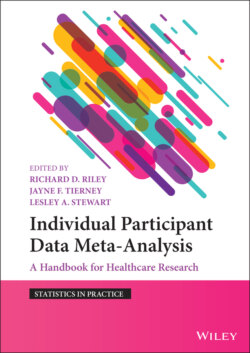Читать книгу Individual Participant Data Meta-Analysis - Группа авторов - Страница 94
4.6.2 Deviations from the Intended Interventions
ОглавлениеWhile robust randomisation procedures should ensure the unbiased assignment to, and comparison of, participants between treatment groups, this can only be guaranteed if all participants are analysed according to the treatments initially assigned: an intention‐to‐treat approach.109–111 Even if a trial has not been analysed appropriately, as long as the IPD have been provided with the original treatment allocation recorded, then participants can be grouped according to this treatment allocation, rather than the treatment they received, enabling an intention‐to‐treat analysis of effectiveness.109–111 However, there may be value in conducting certain analyses based on a subset of participants randomised, such as an analysis of toxicity in just those who received most of their allocated treatment, or sensitivity analyses according to treatment received, to explain differences between published trial results and those used in the meta‐analysis.
There may be sufficient detail in the trial dataset to check whether participants who deviated from intended interventions did so for pre‐specified or otherwise rational reasons. For example, if the data indicate that a participant had experienced an adverse event, this might explain why treatment was stopped early, and would also need to be considered in any analysis of adverse outcomes. It may also be possible to assess whether deviations from planned treatment are similar, and for comparable reasons across treatment groups (more so than with aggregate data).
If a treatment is a major procedure, such as surgery, or particularly toxic, then those delivering treatments and participants will usually be aware of the assigned treatment. Provided that outcomes are objectively measured or ‘hard’, such as mortality, this is unlikely to introduce bias. However, a carer might inadvertently or otherwise deliver a treatment or measure a more subjective outcome, such as an adverse effect, differently if they are aware of which treatment a participant received. Similarly, if a participant is aware of their assigned treatment, it might influence a patient‐reported outcome, such as pain or quality of life. Therefore, in this scenario, there is a potential for bias in this domain, which cannot be alleviated by the collection of IPD. However, the contact with trial teams, that is intrinsic to collaborative IPD meta‐analyses, can provide useful clarification of the methods used to blind participants, carers or outcome assessors, to help determine whether these are appropriate, and therefore allow the risk of bias to be judged with more accuracy.
Figure 4.10 Days of the week participants were allocated to treatment and control groups in a trial included in (a) an IPD meta‐analysis of pre‐operative chemotherapy for non‐small cell lung cancer,88 and (b) an IPD meta‐analysis of post‐operative radiotherapy for non‐small cell lung cancer.107
Source: (a) Based on NSCLC Meta-Analysis Collaborative Group. Preoperative chemotherapy for non-small cell lung cancer: a systematic review and meta-analysis of individual participant data. Lancet 2014;383:1561–71. (b) Based on PORT Meta-analysis Trialists Group. Postoperative radiotherapy in non-small-cell lung cancer: systematic review and meta-analysis of individual patient data from nine randomised controlled trials. The Lancet 1998;352(9124):257–63.
